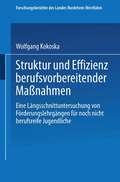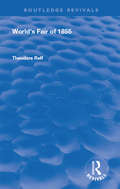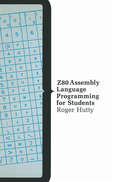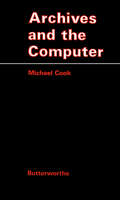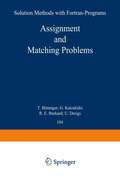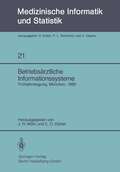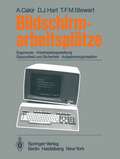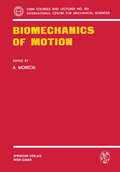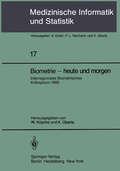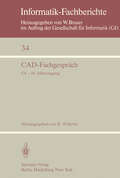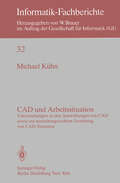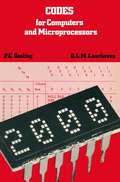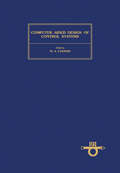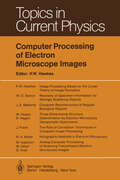- Table View
- List View
Quantum Physics: A Functional Integral Point of View
by J. Glimm A. JaffeThis book is addressed to one problem and to three audiences. The problem is the mathematical structure of modem physics: statistical physics, quantum mechanics, and quantum fields. The unity of mathemati cal structure for problems of diverse origin in physics should be no surprise. For classical physics it is provided, for example, by a common mathematical formalism based on the wave equation and Laplace's equation. The unity transcends mathematical structure and encompasses basic phenomena as well. Thus particle physicists, nuclear physicists, and con densed matter physicists have considered similar scientific problems from complementary points of view. The mathematical structure presented here can be described in various terms: partial differential equations in an infinite number of independent variables, linear operators on infinite dimensional spaces, or probability theory and analysis over function spaces. This mathematical structure of quantization is a generalization of the theory of partial differential equa tions, very much as the latter generalizes the theory of ordinary differential equations. Our central theme is the quantization of a nonlinear partial differential equation and the physics of systems with an infinite number of degrees of freedom. Mathematicians, theoretical physicists, and specialists in mathematical physics are the three audiences to which the book is addressed. Each of the three parts is written with a different scientific perspective.
Readings in Artificial Intelligence
by Bonnie Lynn Webber Nils J. NilssonReadings in Artificial Intelligence focuses on the principles, methodologies, advancements, and approaches involved in artificial intelligence. The selection first elaborates on representations of problems of reasoning about actions, a problem similarity approach to devising heuristics, and optimal search strategies for speech understanding control. Discussions focus on comparison with existing speech understanding systems, empirical comparisons of the different strategies, analysis of distance function approximation, problem similarity, problems of reasoning about action, search for solution in the reduction system, and relationship between the initial search space and the higher level search space. The book then examines consistency in networks of relations, non-resolution theorem proving, using rewriting rules for connection graphs to prove theorems, and closed world data bases. The manuscript tackles a truth maintenance system, elements of a plan-based theory of speech acts, and reasoning about knowledge and action. Topics include problems in reasoning about knowledge, integration knowledge and action, models of plans, compositional adequacy, truth maintenance mechanisms, dialectical arguments, and assumptions and the problem of control. The selection is a valuable reference for researchers wanting to explore the field of artificial intelligence.
Real-Time Parallel Computing: Image Analysis
by Morio OnoeThis book is concerned with the aspects of real-time, parallel computing which are specific to the analysis of digitized images including both the symbolic and semantic data derived from such images. The subjects covered encompass processing, storing, and transmitting images and image data. A variety of techniques and algorithms for the analysis and manipulation of images are explored both theoretically and in terms of implementation in hardware and software. The book is organized into four topic areas: (1) theo retical development, (2) languages for image processing, (3) new computer techniques, and (4) implementation in special purpose real-time digital systems. Computer utilization, methodology, and design for image analy sis presents special and unusual problems. One author (Nagao)* points out that, "Human perception of a scene is very complex. It has not been made clear how perception functions, what one sees in a picture, and how one understands the whole picture. It is almost certain that one carries out a very quick trial-and-error process, starting from the detection of gross prominent features and then analyzing details, using one's knowledge of the world. " Another author (Duff) makes the observation that, "It is therefore more difficult to write computer programs which deal with images than those which deal with numbers, human thinking about arithmetic being a largely conscious activity.
Rechner-Einsatz in der Wasserkraftwirtschaft (Schriftenreihe der Technischen Universität Wien #20)
by K. DorfmeisterErarbeitet am Institut für Energiewirtschaft der Technischen Universität Wien
The Science of Programming (Monographs in Computer Science)
by David GriesDescribes basic programming principles and their step-by- step applications.Numerous examples are included.
Struktur und Effizienz berufsvorbereitender Maßnahmen: Eine Längsschnittuntersuchung von Förderungslehrgängen für noch nicht berufsreife Jugendliche (Forschungsberichte des Landes Nordrhein-Westfalen #3044)
by Wolfgang KokoskaDas Problem der Jugendarbeitslosigkeit, insbesondere des Übergangs von der Schule in die Arbeitswelt, ist zu Beginn der 80er Jahre auch in der Bundesrepublik Deutschland weiter hin virulent. Sowohl in ökonomischer, politischer als auch pädagogischer Dimension sind die strukturellen Merkmale der Ausbildungs- und Berufsnot Jugendlicher noch immer aktuell. Ist zwar einerseits eine gewisse Entspannung insofern einge treten, als die rapide, krisenhafte Ausweitung der Betroffen heit im Verlauf der 70er Jahre zum Stillstand und Rückgang gekommen ist, so kann andererseits immer noch nicht die Rede von einer Bewältigung oder gar dem Ende jugendlicher Berufs startschwierigkeiten sein. Nach dem Tenor gegenwärtiger Wirtschaftsprognosen ist vielmehr davon auszugehen, daß auch noch in absehbarer Zeit beschäftigungs- und arbeitsmarkt intervenierende sowie schul- und berufsbildungspolitisch orientierte Instrumentarien und Strategien, diesem uner wünschten Phänomen gegenzusteuern, erforderlich sein werden. Zumal die Nahtstelle des Übergangs vom allgemeinbildenden in den beruflichen Sektor bedarf auch fernerhin besonderer Zu wendung, markiert sie doch nach wie vor für einen beträcht lichen Teil von Schulabgängern eine nachhaltige Barriere zu qualifizierter Berufsausbildung und beruflicher Tätigkeit.
Studies in Ada Style
by P. Hibbard A. Hisgen J. Rosenberg M. Shaw M. ShermanThe major problems of modern software involve finding effective techniques and tools for organizing and maintaining large, complex programs. The key concept in modern programming for controlling complexity is abstraction; that is, selective emphasis on detail. This monograph discusses how the Ada programming language provides ways to support and exploit such abstraction techniques. The monograph is organized into two parts. The first part traces the important ideas of modern programming languages to their roots in the languages of the past decade and shows how modern languages, such as Ada, respond to contemporary problems in software development. The second part examines five problems to be programmed using Ada. For each problem, a complete Ada program is given, followed by a discussion of how the Ada language affected various design decisions. These problems were selected to be as practical as possible rather than to illustrate any particular set of language features. Much of this material has appeared previously in print. An earlier version of the first section, by Mary Shaw, was published as "The Impact of Abstraction Concerns on Modern Programming Languages" in the Proceedings of the IEEE special issue on Software Engineering, September 1980, Vol. 68, No. 9, pages 1119·1130. It is reprinted with the IEEE's permission. The article has been updated to reflect the revised Ada syntax and semantics.
Telecommunications Switching (Applications of Communications Theory)
by J. Gordon PearceThe motivation for this book stems from an early exposure to the book Ap plied Mechanics by John Perry. Professor Perry strove to encourage his readers to understand the applications and use of mathematics in engineering with out insisting that they become immersed in pure mathematics. The following text uses this approach to the application of telecommunications switching. Readers wishing to study the derivation and proof of formulas will be able to do so using relevant references. The existence of low-cost programmable calculators frees practicing engineers from much laborious calculation, allowing more time for creative design and application of the art. The reader should not need to be able to derive formulas in order to apply them just as, to quote Professor Perry, "He should not have to be able to design a watch in order to tell time ... The material for this book has been drawn from my own experience in the field. Inevitably, however, I have used CCITT and Bell System publications for references and in some cases quotation, and I gratefully acknowledge permission for their use. I am also grateful to Stromberg Carlson Corporation for their earlier encour agement and support without which this book would not have been possible. Thanks are also due to Fred Hadfield for his advice and assistance in the preparation of the many figures and to my wife Ada for her support and patience as I pursued the demanding but interesting task of producing the text.
Werkzeuge der Programmiertechnik: GI-Arbeitstagung Karlsruhe, 16.–17. März 1981. Proceedings (Informatik-Fachberichte #43)
by G. GoosWorld's Fair of 1855 (Routledge Revivals)
by Theodore ReffPublished in 1981: This is two-hundred catalogues of the Major Exhibitions reproduced in facsimile in forty-seven volumes.
World's Fair of 1855 (Routledge Revivals)
by Theodore ReffPublished in 1981: This is two-hundred catalogues of the Major Exhibitions reproduced in facsimile in forty-seven volumes.
Archives and the Computer
by Michael J. CookArchives and the Computer deals with the use of the computer and its systems and programs in archiving data and other related materials. The book covers topics such as the scope of automated systems in archives; systems for records management, archival description, and retrieval; and machine-readable archives. The book also features examples of systems for records management from different institutions such as theTyne and Wear Archive Department, Dyfed Record Office, and the University of Liverpool. Included in the last part are appendices. Appendix A is a directory of archival systems, Appendix B contains guidelines for machine-readable and related records for preservation, and Appendix C covers machine-readable archives. The text is recommended for archivists who would like to know more about the use of computers in archiving of records and other related information.
Assignment and Matching Problems: Solution Methods with FORTRAN-Programs (Lecture Notes in Economics and Mathematical Systems #184)
by R. E. Burkard U. DerigsBetriebsärztliche Informationssysteme: Frühjahrstagung der GMDS, München, 21. – 22. März 1980 (Medizinische Informatik, Biometrie und Epidemiologie #21)
by J. R. Möhr C. O. KöhlerBildschirmarbeitsplätze: Ergonomie Arbeitsplatzgestaltung Gesundheit und Sicherheit Aufgabenorganisation
by A. Cakir D. J. Hart T. F. StewartBiometrie — heute und morgen: Interregionales Biometrisches Kolloquium 1980 der Deutschen Region und Region Österreich — Schweiz der Internationalen Biometrischen Gesellschaft München, 17.–20. März 1980 (Medizinische Informatik, Biometrie und Epidemiologie #17)
by W. Köpcke K. ÜberlaCAD-Fachgespräch: GI — 10. Jahrestagung, Saarbrücken, 30. September – 2. Oktober 1980 (Informatik-Fachberichte #34)
by R. WilhelmCAD und Arbeitssituation: Untersuchungen zu den Auswirkungen von CAD sowie zur menschengerechten Gestaltung von CAD-Systemen (Informatik-Fachberichte #32)
by M. KühnComputer Aided Design of Control Systems: Proceedings of the IFAC Symposium, Zürich, Switzerland, 29-31 August 1979
by M. A. CuenodComputer Aided Design of Control Systems focuses on the use of computers to analyze and design the control of various processes, as well as the development of program packages with different algorithms for digital computers. The selection first takes a look at the computer aided design of minimal order controllers, including design of interacting and noninteracting dynamic controllers of minimal order and basic algorithm. The book then discusses an accelerated Newton process to solve Riccati equation through matrix sign function; suboptimal direct digital control of a trickle-bed absorption column; and structural design of large systems employing a geometric approach. The text underscores the computer as an aid for the implementation of advanced control algorithms on physical processes and analysis of direct control algorithms and their parallel realization. Topics include hardware influences on the control, process influence, and interactive structure design of direct control systems. The book also takes a look at the optimal control of randomly sampled linear stochastic systems; computer aided design of suboptimal test signals for system identification; and computer aided design of multi-level systems with prescribed structure and control constraints. The selection is a dependable source of data for readers interested in the uses of computers.
Computer Processing of Electron Microscope Images (Topics in Current Physics #13)
by J. Frank P. W. Hawkes R. Hegerl W. Hoppe M. S. Isaacson D. Kopf J. E. Mellema W. O. Saxton M. Utlaut R. H. WadeTowards the end of the 1960s, a number of quite different circumstances combined to launch a period of intense activity in the digital processing of electron micro graphs. First, many years of work on correcting the resolution-limiting aberrations of electron microscope objectives had shown that these optical impediments to very high resolution could indeed be overcome, but only at the cost of immense exper imental difficulty; thanks largely to the theoretical work of K. -J. Hanszen and his colleagues and to the experimental work of F. Thon, the notions of transfer func tions were beginning to supplant or complement the concepts of geometrical optics in electron optical thinking; and finally, large fast computers, capable of manipu lating big image matrices in a reasonable time, were widely accessible. Thus the idea that recorded electron microscope images could be improved in some way or rendered more informative by subsequent computer processing gradually gained ground. At first, most effort was concentrated on three-dimensional reconstruction, particu larly of specimens with natural symmetry that could be exploited, and on linear operations on weakly scattering specimens (Chap. l). In 1973, however, R. W. Gerchberg and W. O. Saxton described an iterative algorithm that in principle yielded the phase and amplitude of the electron wave emerging from a strongly scattering speci men.







